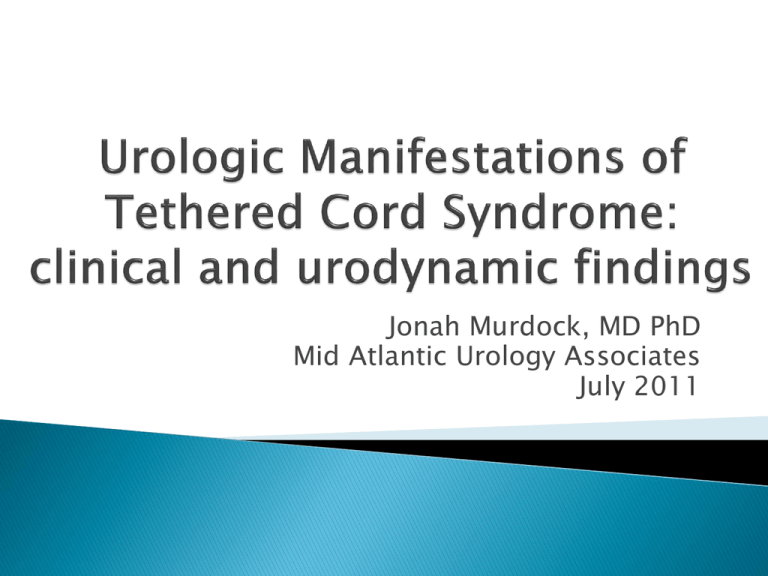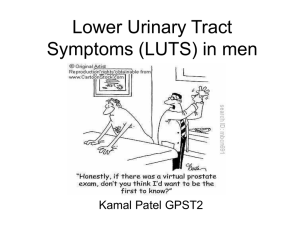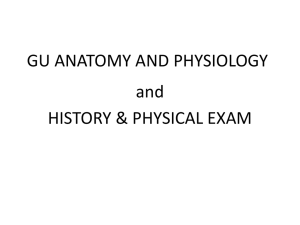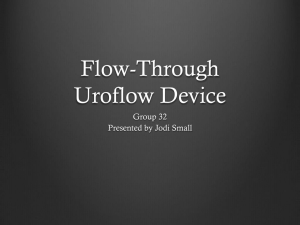
Jonah Murdock, MD PhD
Mid Atlantic Urology Associates
July 2011
Understand the relationship between EhlersDanlos syndrome, tethered cord syndrome,
and neurogenic bladder
Define the role for Urodynamics in diagnosing
tethered cord
Sequela of deformative stress injury to distal
spinal cord
Nerves serving the pelvis (e.g. bladder) and lower
extremities do not function due to deformative
stress
with Ehlers-Danlos more common than
previously thought
Urologic symptoms
◦
◦
◦
◦
Not specific & frequently not acknowledged
Can’t feel when bladder is full
Bladder always feels full
Severe straining and intermittent stream when voiding
Aufschnaiter (2008) Neurosurg Rev 31(4):371
Literature review (n=386)
Average age of symptom onset 36.5 years
Predominant symptom: pain and weakness
lower extemities
Precipitating incident: trauma, excessive
physical training
Potential problems from Ehlers-Danlos:
1) Bladder muscle laxity can cause voiding
problems
2) Functional impairment of bladder’s nerves
by tethered cord can cause voiding problems
Ehlers-Danlos Syndrome
◦ Abnormal connective tissue
Associated Genitourinary Abnormalities
◦
◦
◦
◦
◦
Enlarged bladder and bladder diverticuli
Incomplete Bladder Emptying
Enlarged Ureter
Prolapse
Incontinece
E-D can result in bladder laxity, a large
sacculated poorly emptying bladder
◦ Prone to urinary tract infections
Treatment:
◦
◦
◦
◦
Timed voiding
Double voiding to empty bladder
Antibiotic prophylaxis
Surgery: bladder diverticulectomy
• Symptoms
Involuntary leakage with coughing and sneezing
Sensation of bulge
• Treatment: Surgery
• Use caution due to risk of poor wound healing and
recurrence
How does a tethered cord cause abnormal
voiding?
Pelvic and sacral nerves impaired function
◦ Control bladder storage of urine
◦ Control emptying of urine at void
Symptoms
◦ Can’t feel when bladder is full
◦ Bladder always feels full
◦ Severe straining and intermittent stream when
voiding
Bladder filling
Bladder emptying
◦ Bladder relaxes &
◦ urethral sphincter contracts
(to keep urine in)
◦ Bladder contracts after
◦ Urethral sphincter relaxes
(to let urine out)
Sacral nerves (S2,S3,S4)
Pelvic nerves
Hypogastric nerve
control urethral sphincter
(parasympathetic system)
control bladder
contraction
(sympathetic system)
control bladder relaxation
Neurogenic Bladder=abnormal bladder
function from sacral and pelvic nerve
dysfunction
Detrusor Sphincter Dyssinergia
◦ Sphincter contracts at voiding
◦ Symptoms: hesitancy and straining at void
Hypercontractile Neurogenic Bladder
◦ Bladder contracts during filling
◦ Symptoms: urgency, frequency, incontinence
Scant literature
Small series
No consensus
Urodynamics
1) Measure bladder storage (cystometrogram)
◦ bladder compliance, sensation, and capacity
2) Measure voiding
◦ Bladder pressure, urinary flow, coordination of
bladder and external sphincter
Urodynamic abnormality reflects nerve
dysfunction
◦ peripheral (e.g.sacral nerve) dysfunction or
◦ central (e.g. cervical spine) nerve dysfuntion
Uncover occult bladder dysfunction
Confirm clinical and radiologic diagnosis
Identify response to treatment
Measure pressure in the bladder
◦ While it fills
◦ During voiding
Measure pressure of the urinary sphincter
◦ During bladder filling
◦ During voiding
Measure the urinary stream
◦ Force and pattern of the urinary stream at void
Place pressure sensing catheters in the
bladder, the rectum and near the urethral
sphincter
Hypercontractile
Neurogenic Bladder
or Overactive Bladder
Detrusor sphinctor dyssinergia
Large Capacity
Hyposensory Bladder
Bladder hypotonia with
poor urinary flow pattern
Scant Literature
Husman (1995) Occult spinal dysraphism (the
tethered cord) and the urologist.
◦ There is no typical urologic dysfunction
◦ Treatment is based on urodynamic evaluation
n=20
Symptoms: irritative voiding,
incontinence, and retention
Most Common Symptoms: urgency
(67%) and urge incontinence (50%)
Urodynamic findings: detrusor hyperreflexia
(72%), Detrusor external sphincter dyssinergia
(22%), decreased sensation (17%), decreased
compliance (17%), hypocontractile detrusor (11%)
Postoperative improvement in only 29% (n=4 pts)
n=18
Urodynamic findings: “flaccid bladder”50%,
“uninhibited bladder” 28%, “mixed bladder
dysfunction” 11%, Normal 11%
Postoperative improvement:
◦ Uninhibited bladder resolved in all
◦ Flaccid bladder resolved or improved in 45%
n=15
93% with abnormal urodynamics
◦ Detrusor areflexia 60%
Postop restoration of bladder function 67%
Poor postoperative function:
◦ If bladder symptoms >3 years
◦ Cutaneous stigma
n=29
48% had urinary symptoms
◦ 47% had postsurgical improvement of urinary
symptoms
◦ Mean time to urinary symptom improvement 4.3
months (vs 1 month for pain improvement)
•
•
•
•
n=43
Ehlers-Danlos
85% with radiologic evidence of tethered cord
Standard symptom questionnaire
• All with tethered cord symptoms
• 60% have urologic symptoms
•
Urodynamics performed on all preoperatively
of Patients with Ehlers-Danlos & tethered
cord symptoms:
75% have abnormal urodynamics
◦ 37% hyposensory bladder with retention
◦ 34% hypertonic bladder
◦ 28%% detrusor sphincter dyssinergia
25% have normal urodynamics
Abnormal urodynamics (n=14):
◦ 86% Symptom improvement after surgery
◦ 14% No symptom improvement after surgery
Normal urodynamics (n=3):
◦ 100% symptom improvement
◦ (not all patients with tethered cord have abnormal
urodynamics)
Tethered cord surgery results
n=13 (Dr. F Henderson)
12
10
8
Improved
6
Worsened
4
No change
2
0
Neurological Functional
Change
Change
Quality of Pain Change
Life
1) Surgical detethering: sectioning the filum
terminale
2) If residual symptoms after correction of
tethered cord:
Detrusor Sphincter Dyssinergia
◦ Medical management: Alpha blocker
Large capacity bladder
◦ Timed voiding
Hypercontractile bladder
◦ Medical management, Anti-muscarinic
Abnormal urodynamics is present even in the
absence of lower urinary tract symptoms in
most patients with tethered cord
Most common urodynamic findings are:
hypertonic bladder, bladder hypotonia with
urinary retention, and detrusor sphincter
dysinergia
Tethered cord is common among properly
screened patients with Ehlers Danlos
syndrome
Urodynamics is a good predictor alongside
clinical symptoms and radiography in
diagnosing tethered cord and predicting a
good response to surgery
Dr. Fraser Henderson
Mackenzie Mathis
Jenna Sherry
Dr. Myron Murdock












